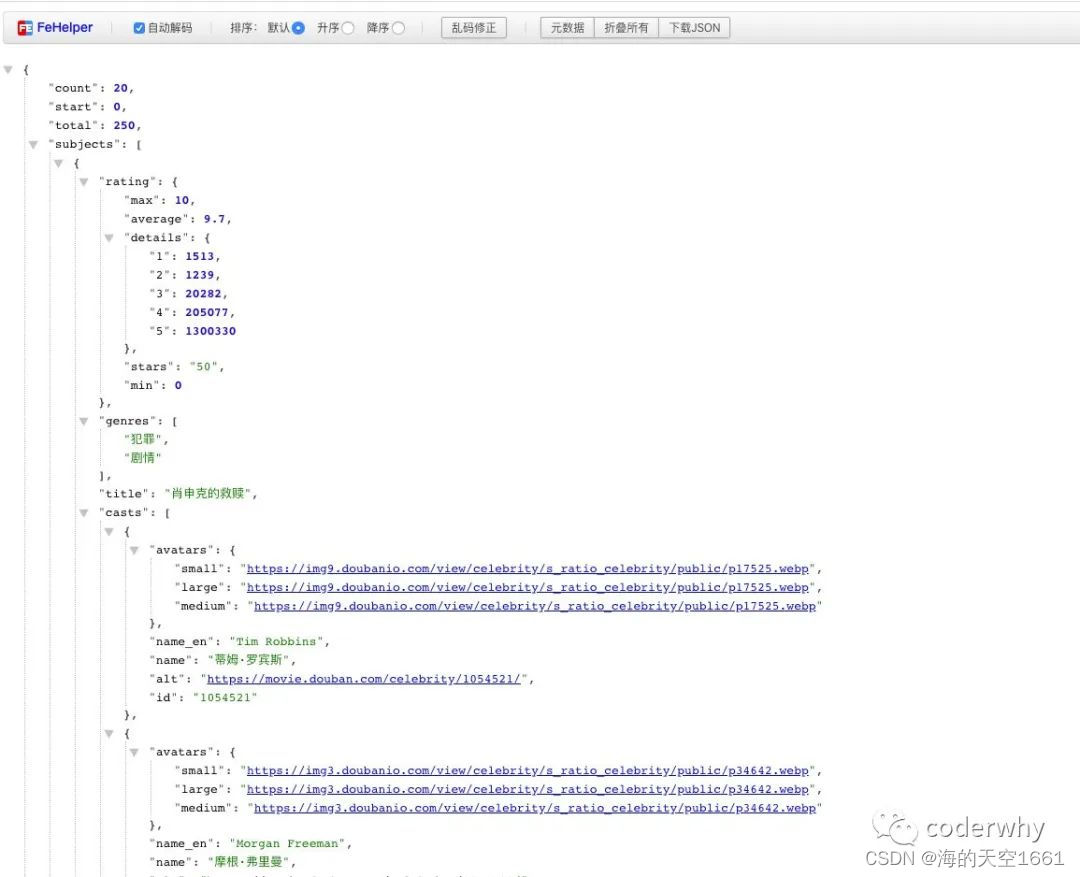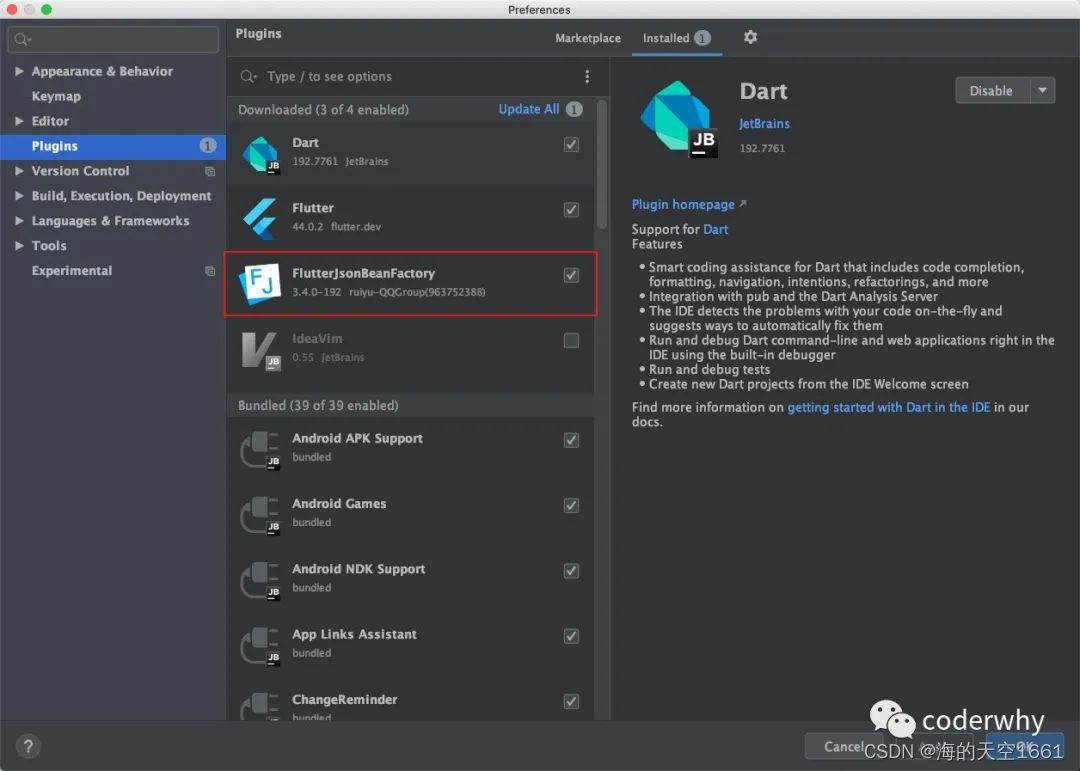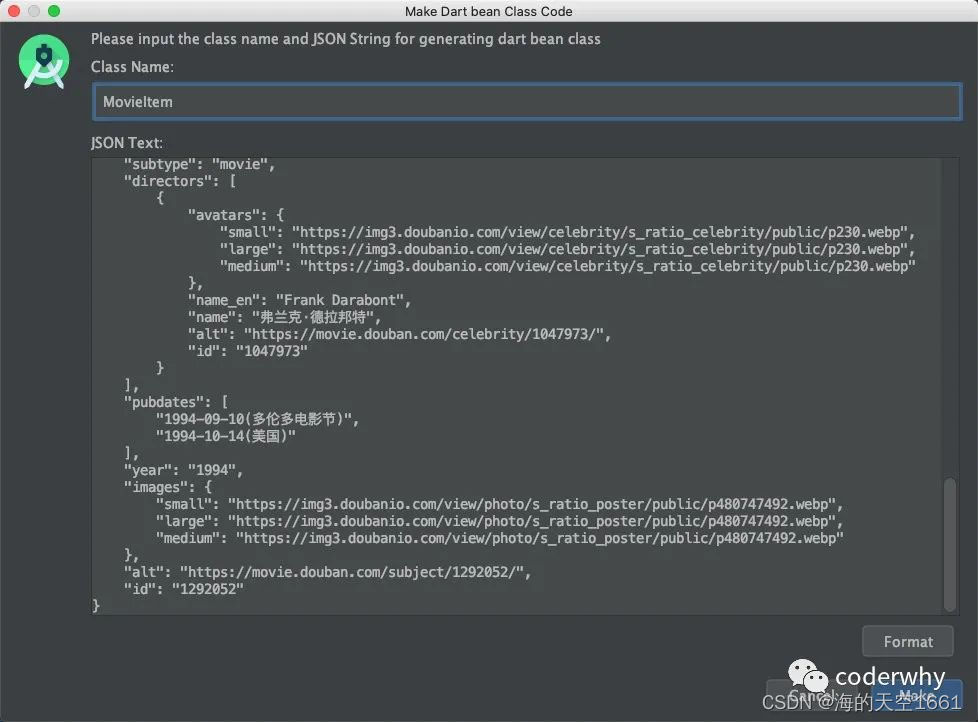Flutter如何JSON转Model
在开发中,服务端通常给我们返回的是JSON数据,我们需要将JSON数据转成我们的模型对象来使用。
在Flutter中,有几种JSON转模型的方式,我们还是以豆瓣为例,来进行一个演练;
一. 豆瓣数据
这里我们使用豆瓣的请求地址:
-
https://douban.uieee.com/v2/movie/top250?start=0&count=20
在浏览器中请求,获取到的数据如下:
-
注意:这里我使用了一个格式化插件:FeHelper,所以结构看起来很清晰
-

image-20200318110639561
这个数据还是比较复杂的:
-
如果我们希望在Flutter代码中使用,直接将JSON转成Map来使用也可以,但是非常麻烦,而且类型会不容易确定,并且不安全;
-
所以对于面向对象开发的语言,我们通常都会将它转成模型对象,之后使用一个个模型对象;
我们一起来探究一下,目前Flutter中比较常见的将JSON转成模型的方式。
二. 手动转化
JSON转模型,必然可以通过手动来进行转化:
-
优点:完全是自己可控的,并且需要哪些字段就转化哪些字段,对于不需要的,忽略即可;并且继承关系也会一目了然
-
缺点:麻烦,并且容易出错;
下面是我之前针对上面的数据,写的JSON转Model的模型类:
class Person {
String name;
String avatarURL;
Person.fromMap(Map<String, dynamic> json) {
this.name = json["name"];
this.avatarURL = json["avatars"]["medium"];
}
}
class Actor extends Person {
Actor.fromMap(Map<String, dynamic> json): super.fromMap(json);
}
class Director extends Person {
Director.fromMap(Map<String, dynamic> json): super.fromMap(json);
}
int counter = 1;
class MovieItem {
int rank;
String imageURL;
String title;
String playDate;
double rating;
List<String> genres;
List<Actor> casts;
Director director;
String originalTitle;
MovieItem.fromMap(Map<String, dynamic> json) {
this.rank = counter++;
this.imageURL = json["images"]["medium"];
this.title = json["title"];
this.playDate = json["year"];
this.rating = json["rating"]["average"];
this.genres = json["genres"].cast<String>();
this.casts = (json["casts"] as List<dynamic>).map((item) {
return Actor.fromMap(item);
}).toList();
this.director = Director.fromMap(json["directors"][0]);
this.originalTitle = json["original_title"];
}
}
三. json_serializable
json_serializable是dart官方推荐和提供的JSON转Model的方式:
-
一个自动化源代码生成器来为你生成 JSON 序列化数据模板;
-
由于序列化数据代码不再需要手动编写或者维护,你可以将序列化 JSON 数据在运行时的异常风险降到最低;
第一步:添加相关的依赖
依赖分为项目依赖(dependencies),开发依赖(dev_dependencies):
-
注意:需要执行flutter pub get确保我们的项目中有这些依赖
dependencies:
json_annotation: ^3.0.1
dev_dependencies:
json_serializable: ^3.2.5
build_runner: ^1.8.0
第二步:以json_serializable 的方式创建模型类
这里不以豆瓣数据为例,以一个简单的Json数据作为例子
final jsonInfo = {
"nickname": "coderwhy",
"level": 18,
"courses": ["语文", "数学", "英语"],
"register_date": "2222-2-22",
"computer": {
"brand": "MackBook",
"price": 1000
}
};
创建对应的模型(以json_serializable 的方式,创建完成后代码是报错的)
-
1.part 'user.g.dart'
-
这个是之后json_serializable会自动帮助我们生成的文件
-
-
2.JsonSerializable()
-
注解:告诉json_serializable哪一个类需要进行转换
-
-
3.JsonKey
-
当映射关系不一样时,可以指定映射关系
-
-
4.另外,这里必须有我们的构造方法
-
5.需要有对应的工厂构造器
-
_UserFromJson(json)和_UserToJson(this)调用的该方法目前会报错,需要json_serializable来生成
-
-
6.toString方法不是必须的,是待会儿进行测试的
User类的代码:
import 'package:json_annotation/json_annotation.dart';
import 'model/computer.dart';
part 'user.g.dart';
@JsonSerializable()
class User {
String name;
String email;
@JsonKey(name: "register_date")
String registerDate;
List<String> courses;
Computer computer;
User(this.name, this.email, this.registerDate, this.courses, this.computer);
factory User.fromJson(Map<String, dynamic> json) => _$UserFromJson(json);
Map<String, dynamic> toJson() => _$UserToJson(this);
@override
String toString() {
return 'User{name: $name, email: $email, registerDate: $registerDate, courses: $courses, computer: $computer}';
}
}
Computer类的代码:
import 'package:json_annotation/json_annotation.dart';
part 'computer.g.dart';
@JsonSerializable()
class Computer {
String brand;
double price;
Computer(this.brand, this.price);
factory Computer.fromJson(Map<String, dynamic> json) => _$ComputerFromJson(json);
Map<String, dynamic> toJson() => _$ComputerToJson(this);
@override
String toString() {
return 'Computer{brand: $brand, price: $price}';
}
}
第三步:生成JSON序列化代码
在项目终端运行下面的指令:
-
该指令是生成一次JSON序列化的代码
flutter pub run build_runner build
或运行下面的指令:
-
会监听文件的改变,重新生成JSON序列化的代码
flutter pub run build_runner watch
第四步:测试代码
final jsonInfo = {
"nickname": "coderwhy",
"level": 18,
"courses": ["语文", "数学", "英语"],
"register_date": "2222-2-22",
"computer": {
"brand": "MackBook",
"price": 1000
}
};
final user = User.fromJson(jsonInfo);
print(user);
更多资料,请查看下面的资源:
-
dart:convert和JsonCodec文档 -
Pub 中的 json_serializable package
-
GitHub 中的 json_serializable 例子
四. 网页转换
目前有一些网页,可以直接将JSON转成Model
-
网页推荐:https://javiercbk.github.io/json_to_dart/
-
最新推荐:https://app.quicktype.io (可以转dart模型,还可以转成swift、java模型等等)
我们这里以网页版本为例,非常简单:
-
注意:可能因为豆瓣的数据过于复杂,所以在生成的时候发现少了一个Directors类
-
这里我重新复制对应的JSON,再次生成了一下
-

image-20200318155605684
class MovieItem {
Rating rating;
List<String> genres;
String title;
List<Casts> casts;
List<String> durations;
int collectCount;
String mainlandPubdate;
bool hasVideo;
String originalTitle;
String subtype;
List<Directors> directors;
List<String> pubdates;
String year;
Avatars images;
String alt;
String id;
MovieItem(
{this.rating,
this.genres,
this.title,
this.casts,
this.durations,
this.collectCount,
this.mainlandPubdate,
this.hasVideo,
this.originalTitle,
this.subtype,
this.directors,
this.pubdates,
this.year,
this.images,
this.alt,
this.id});
MovieItem.fromJson(Map<String, dynamic> json) {
rating =
json['rating'] != null ? new Rating.fromJson(json['rating']) : null;
genres = json['genres'].cast<String>();
title = json['title'];
if (json['casts'] != null) {
casts = new List<Casts>();
json['casts'].forEach((v) {
casts.add(new Casts.fromJson(v));
});
}
durations = json['durations'].cast<String>();
collectCount = json['collect_count'];
mainlandPubdate = json['mainland_pubdate'];
hasVideo = json['has_video'];
originalTitle = json['original_title'];
subtype = json['subtype'];
if (json['directors'] != null) {
directors = new List<Directors>();
json['directors'].forEach((v) {
directors.add(new Directors.fromJson(v));
});
}
pubdates = json['pubdates'].cast<String>();
year = json['year'];
images =
json['images'] != null ? new Avatars.fromJson(json['images']) : null;
alt = json['alt'];
id = json['id'];
}
Map<String, dynamic> toJson() {
final Map<String, dynamic> data = new Map<String, dynamic>();
if (this.rating != null) {
data['rating'] = this.rating.toJson();
}
data['genres'] = this.genres;
data['title'] = this.title;
if (this.casts != null) {
data['casts'] = this.casts.map((v) => v.toJson()).toList();
}
data['durations'] = this.durations;
data['collect_count'] = this.collectCount;
data['mainland_pubdate'] = this.mainlandPubdate;
data['has_video'] = this.hasVideo;
data['original_title'] = this.originalTitle;
data['subtype'] = this.subtype;
if (this.directors != null) {
data['directors'] = this.directors.map((v) => v.toJson()).toList();
}
data['pubdates'] = this.pubdates;
data['year'] = this.year;
if (this.images != null) {
data['images'] = this.images.toJson();
}
data['alt'] = this.alt;
data['id'] = this.id;
return data;
}
}
class Rating {
int max;
double average;
Details details;
String stars;
int min;
Rating({this.max, this.average, this.details, this.stars, this.min});
Rating.fromJson(Map<String, dynamic> json) {
max = json['max'];
average = json['average'];
details =
json['details'] != null ? new Details.fromJson(json['details']) : null;
stars = json['stars'];
min = json['min'];
}
Map<String, dynamic> toJson() {
final Map<String, dynamic> data = new Map<String, dynamic>();
data['max'] = this.max;
data['average'] = this.average;
if (this.details != null) {
data['details'] = this.details.toJson();
}
data['stars'] = this.stars;
data['min'] = this.min;
return data;
}
}
class Details {
int i1;
int i2;
int i3;
int i4;
int i5;
Details({this.i1, this.i2, this.i3, this.i4, this.i5});
Details.fromJson(Map<String, dynamic> json) {
i1 = json['1'];
i2 = json['2'];
i3 = json['3'];
i4 = json['4'];
i5 = json['5'];
}
Map<String, dynamic> toJson() {
final Map<String, dynamic> data = new Map<String, dynamic>();
data['1'] = this.i1;
data['2'] = this.i2;
data['3'] = this.i3;
data['4'] = this.i4;
data['5'] = this.i5;
return data;
}
}
class Casts {
Avatars avatars;
String nameEn;
String name;
String alt;
String id;
Casts({this.avatars, this.nameEn, this.name, this.alt, this.id});
Casts.fromJson(Map<String, dynamic> json) {
avatars =
json['avatars'] != null ? new Avatars.fromJson(json['avatars']) : null;
nameEn = json['name_en'];
name = json['name'];
alt = json['alt'];
id = json['id'];
}
Map<String, dynamic> toJson() {
final Map<String, dynamic> data = new Map<String, dynamic>();
if (this.avatars != null) {
data['avatars'] = this.avatars.toJson();
}
data['name_en'] = this.nameEn;
data['name'] = this.name;
data['alt'] = this.alt;
data['id'] = this.id;
return data;
}
}
class Directors {
Avatars avatars;
String nameEn;
String name;
String alt;
String id;
Directors({this.avatars, this.nameEn, this.name, this.alt, this.id});
Directors.fromJson(Map<String, dynamic> json) {
avatars =
json['avatars'] != null ? new Avatars.fromJson(json['avatars']) : null;
nameEn = json['name_en'];
name = json['name'];
alt = json['alt'];
id = json['id'];
}
Map<String, dynamic> toJson() {
final Map<String, dynamic> data = new Map<String, dynamic>();
if (this.avatars != null) {
data['avatars'] = this.avatars.toJson();
}
data['name_en'] = this.nameEn;
data['name'] = this.name;
data['alt'] = this.alt;
data['id'] = this.id;
return data;
}
}
class Avatars {
String small;
String large;
String medium;
Avatars({this.small, this.large, this.medium});
Avatars.fromJson(Map<String, dynamic> json) {
small = json['small'];
large = json['large'];
medium = json['medium'];
}
Map<String, dynamic> toJson() {
final Map<String, dynamic> data = new Map<String, dynamic>();
data['small'] = this.small;
data['large'] = this.large;
data['medium'] = this.medium;
return data;
}
}
五. 编辑器插件
目前也有一些AndroidStudio或者VSCode的插件,来帮助我们直接将JSON生成对应的Model
-
VSCode目前没有找到比较好用的插件推荐
-
Android Studio推荐FlutterJsonBeanFactory
第一步:安装插件

安装插件
第二步:创建模型
右键新建文件:

新建文件
给类起一个名字,并且将JSON复制过去

转换界面
第三步:使用生成的模型
创建完成后会生成对应的模型,并且还会生成一个文件夹,里面有生成模型过程的代码
-
这里不再给出,代码都是相似的





















 1470
1470











 被折叠的 条评论
为什么被折叠?
被折叠的 条评论
为什么被折叠?








